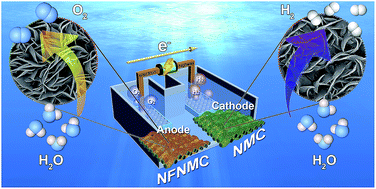Asymmetric electrodes with a transition metal disulfide heterostructure and amorphous bimetallic hydroxide for effective alkaline water electrolysis†
Abstract
Through hydro- and solvothermal methods and an electrodeposition-assisted in situ growth strategy, a transition metal disulfide (TMD)-assembled heterostructural cathode (Ni3S2/MoS2-CC) and derivative TMD superficial amorphous bimetallic hydroxide-coated anode (NiFe(OH)x@Ni3S2/MoS2-CC) were successfully prepared for the hydrogen evolution reaction (HER) and oxygen evolution reaction (OER), respectively. The synthesized electrodes demonstrate first-rate performance with enhanced durability for electrolysis. Individually, Ni3S2/MoS2-CC affords an overpotential (η) of 173 mV (at 100 mA cm−2) in HER, while NiFe(OH)x@Ni3S2/MoS2-CC affords an η of 309 mV (at 100 mA cm−2) in OER. Tight interstratification between the nanosheet (NS) array and amorphous bimetallic hydroxides lead to enhanced affinity for OH−/H+, improved conductivity, increased charge transfer, and enriched active sites. The two-electrode alkaline (1.0 M KOH) electrolyzer (NMC//NFNMC) requires a low overall voltage (ΔV) of 1.55 and 1.71 V to reach 10 and 100 mA cm−2, respectively. The rational combination of TMDs and TMDs/NiFe(OH)x delivers a useful methodology for designing and constructing low-cost, hierarchical, transition metal-based composite catalysts with high performance for water electrolysis.



 Please wait while we load your content...
Please wait while we load your content...